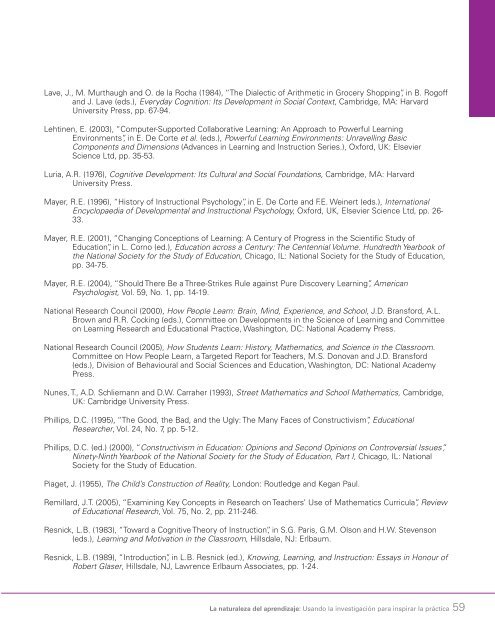del aprendizaje
2aGaJxc
2aGaJxc
Create successful ePaper yourself
Turn your PDF publications into a flip-book with our unique Google optimized e-Paper software.
Lave, J., M. Murthaugh and O. de la Rocha (1984), “The Dialectic of Arithmetic in Grocery Shopping”, in B. Rogoff<br />
and J. Lave (eds.), Everyday Cognition: Its Development in Social Context, Cambridge, MA: Harvard<br />
University Press, pp. 67-94.<br />
Lehtinen, E. (2003), “Computer-Supported Collaborative Learning: An Approach to Powerful Learning<br />
Environments”, in E. De Corte et al. (eds.), Powerful Learning Environments: Unravelling Basic<br />
Components and Dimensions (Advances in Learning and Instruction Series.), Oxford, UK: Elsevier<br />
Science Ltd, pp. 35-53.<br />
Luria, A.R. (1976), Cognitive Development: Its Cultural and Social Foundations, Cambridge, MA: Harvard<br />
University Press.<br />
Mayer, R.E. (1996), “History of Instructional Psychology”, in E. De Corte and F.E. Weinert (eds.), International<br />
Encyclopaedia of Developmental and Instructional Psychology, Oxford, UK, Elsevier Science Ltd, pp. 26-<br />
33.<br />
Mayer, R.E. (2001), “Changing Conceptions of Learning: A Century of Progress in the Scientific Study of<br />
Education”, in L. Corno (ed.), Education across a Century: The Centennial Volume. Hundredth Yearbook of<br />
the National Society for the Study of Education, Chicago, IL: National Society for the Study of Education,<br />
pp. 34-75.<br />
Mayer, R.E. (2004), “Should There Be a Three-Strikes Rule against Pure Discovery Learning”, American<br />
Psychologist, Vol. 59, No. 1, pp. 14-19.<br />
National Research Council (2000), How People Learn: Brain, Mind, Experience, and School, J.D. Bransford, A.L.<br />
Brown and R.R. Cocking (eds.), Committee on Developments in the Science of Learning and Committee<br />
on Learning Research and Educational Practice, Washington, DC: National Academy Press.<br />
National Research Council (2005), How Students Learn: History, Mathematics, and Science in the Classroom.<br />
Committee on How People Learn, a Targeted Report for Teachers, M.S. Donovan and J.D. Bransford<br />
(eds.), Division of Behavioural and Social Sciences and Education, Washington, DC: National Academy<br />
Press.<br />
Nunes, T., A.D. Schliemann and D.W. Carraher (1993), Street Mathematics and School Mathematics, Cambridge,<br />
UK: Cambridge University Press.<br />
Phillips, D.C. (1995), “The Good, the Bad, and the Ugly: The Many Faces of Constructivism”, Educational<br />
Researcher, Vol. 24, No. 7, pp. 5-12.<br />
Phillips, D.C. (ed.) (2000), “Constructivism in Education: Opinions and Second Opinions on Controversial Issues”,<br />
Ninety-Ninth Yearbook of the National Society for the Study of Education, Part I, Chicago, IL: National<br />
Society for the Study of Education.<br />
Piaget, J. (1955), The Child’s Construction of Reality, London: Routledge and Kegan Paul.<br />
Remillard, J.T. (2005), “Examining Key Concepts in Research on Teachers’ Use of Mathematics Curricula”, Review<br />
of Educational Research, Vol. 75, No. 2, pp. 211-246.<br />
Resnick, L.B. (1983), “Toward a Cognitive Theory of Instruction”, in S.G. Paris, G.M. Olson and H.W. Stevenson<br />
(eds.), Learning and Motivation in the Classroom, Hillsdale, NJ: Erlbaum.<br />
Resnick, L.B. (1989), “Introduction”, in L.B. Resnick (ed.), Knowing, Learning, and Instruction: Essays in Honour of<br />
Robert Glaser, Hillsdale, NJ, Lawrence Erlbaum Associates, pp. 1-24.<br />
La naturaleza <strong>del</strong> <strong>aprendizaje</strong>: Usando la investigación para inspirar la práctica 59


